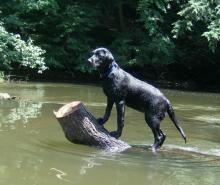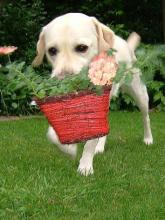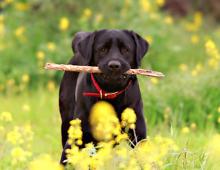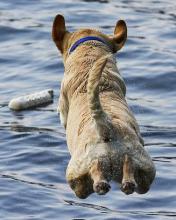
Labrador in its Element - The Water |
| Size | height male 22-24 inches, female 21-23 inches |
| Weight | 65-80 lbs, female 55-70lbs |
| Lifespan | 10-12 years |
| Category | Breed Group Gun Dog AKC Group Sporting |

Labrador Puppy Helping in the Garden 
Lab Showing Good Retrieving Skils 
Labrador at Agility Contest |
Labrador RetrieverDescription The Labrador Retriever is Americaís favorite dog, frequently heading the AKCís most popular breeds list. The Labrador is strong, intelligent, energetic and playful, a versatility reflected in a multitude of job descriptions such as guide dog, police dog, mine-detecting dog, gundog and loving family pet. History This breed originated not from Labrador on the mainland of Canada, but on Newfoundland the large island off the east coast. The number one industry on Newfoundland was (as is) fishing and in the 18th century, every fishing boat had a St Johns Water dog on board, a valued member of the crew. When the boat returned to shore, the dog would jump overboard and tow the end of the fish-laden net to shore, so the men could finish the job of landing the fish. Early in the 19th century, the Duke of Malmesbury reputedly heard of the dog, and had several imported to work as gun dogs on his estate. The Duke nicknamed his dogs ĎLabradorsí (as presumably his knowledge of Canadian geography was a little sketchy). The breed thrived in England, rapidly gaining popularity, and fanciers drew up a list of definitive standards. The breed was recognized by the English Kennel Club in 1903, and by the AKC in 1917. Temperament The Labrador is loyal, gentle, good-natured, clever, and very reliable with kids. The dog is attentive and very eager to please, making training straightforward. Care and Exercise A small amount of daily brushing will keep the coat shiny and clean. The Labrador needs lots of vigorous exercise, including swimming, so is best considered as a country, rather than town, dog. Puppies Seven or eight puppies form the typical litter. They are born with adult coloration, are easy to raise, and amenable to training from the age of around 2 months. Health This breed is prone to hip and elbow problems, and a number of eye disorders. |
|
Why in 100 Best? A well-mannered dog, loving and very tolerant of rombustious kids. |
|
Anything you'd like to say about Labrador Retriever? Listing contributed by Suzannah Amend Listing Remove Listing |
| At A Glance | ||
|---|---|---|
| Size | ||
| Affectionate | ||
| Exercise Needs | ||
| Grooming Needs | ||
| Easy to Train | ||
| Watchdog Ability | ||
| Good with Kids | ||
|
Wallpapers Download these high-resolution images to use them as wallpapers for your mobile or desktop screens. |
|
Clips |
Tags gun dog, sporting dog
Disclaimer 100 Best Everything does not guarantee the accuracy of any listing. Please report offensive listings for removal.



